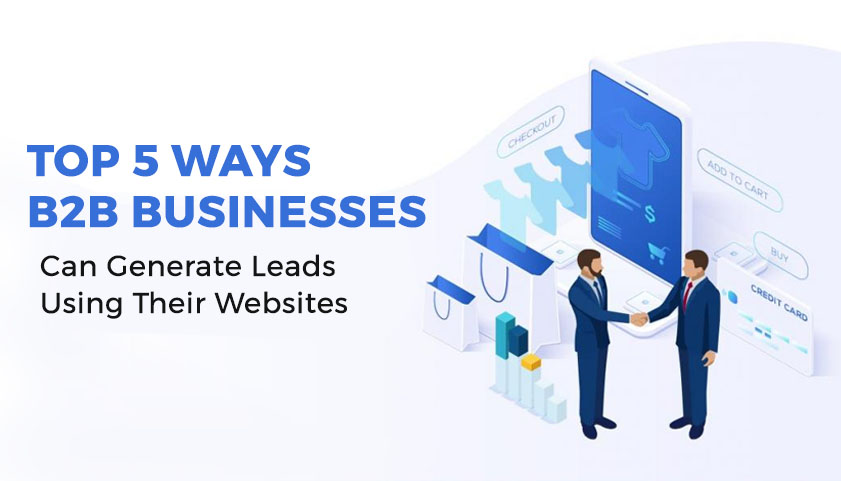
High-quality leads are the driving force behind every business. You need a consistent flow of leads to drive sales and skyrocket revenue. In the absence of a rock-solid lead generation strategy, you’ll struggle to take your business to the next level.
But what’s the first thing that comes to your mind when you think about lead generation? If you’re like B2B marketers, you’re likely reaching out to potential leads on LinkedIn or you might be busy working on various email marketing campaigns.
What many B2B businesses don’t realize is that their websites are like goldmines of lead generation opportunities. That’s because a website is a crucial part of every company’s online presence. Nearly 74% of B2B buyers (Source: https://www.demandgenreport.com/) research a majority of prospective vendors online before making a purchase.
In this blog, we’ve outlined a few simple ways to use your website for lead generation. Let’s take a look.
1. Prioritize SEO
Search engine optimization (SEO) isn’t just one of the most effective digital marketing strategies. When done right, it can be equally valuable for B2B lead generation. A recent report suggests that B2B businesses generate nearly 14% of their leads using SEO while spending only 12% of their budget.
So, if you’re looking for a cost-effective way to populate your sales funnel with top-notch leads, SEO is the way to go.
Start by identifying the keywords your competitors are using to attract website traffic. Next, select and target long-tail keywords to drive qualified visitors to your website. Such visitors have a higher likelihood of converting into leads.
Incorporate the keywords in your website content, including product/service descriptions and blog posts. Also, use the keywords to draft SEO-friendly title tags and meta descriptions for each web page.
2. Invest in Lead Magnets
The B2B buying process often involves a ton of deliberation and discussions among senior-level decision-makers. Empowering B2B buyers with meaningful, interesting, and valuable content is an excellent way to grab their attention and win their trust.
That highlights the importance of creating lead magnets, such as whitepapers, industry reports, infographics, and buying guides, and promoting them on your website. Before getting started, identify topics that’ll resonate with your target buyers and address their pain points.
Create dedicated landing pages for each lead magnet and optimize it using relevant keywords. Also, use attractive yet simple calls-to-action (CTAs) for each lead magnet to encourage website visitors to download it.
3. Offer a Free Tool
Adding a free tool to your website is a clever tactic that encourages potential buyers to give your product a try. It positions your company as respectable, reliable, and authoritative. The best part is that you can ask for their contact information before granting them access to the free tool.
As with lead magnets, you have to understand the main points your target buyers face and create a tool that resolves their problems. For instance, if you’re running a digital marketing agency, you can add a free SEO analysis tool to your website. It’ll help visitors check the current status of their website and motivate them to reach out to you for help.
4. Publish Case Studies
Case studies help showcase the experiences and success stories of your existing clients. Think of them as a vote of confidence for your products/services. You can use them to gain trust and encourage website visitors to get in touch with you.
Read : Why SEO IS Important for your business
Use data and statistics in every case study to highlight how your company helped a client’s business overcome various challenges. Include quotes from relevant stakeholders to highlight their experience of working with you. Make it visually engaging with charts and infographics.
5. Create Irresistible CTAs
Here’s the thing – even the best case study or whitepaper won’t generate any leads if your website visitors don’t download it. That emphasizes the importance of working on every CTA on your website
Use contrasting colors, striking shapes, and animations to help your CTAs stand out. Also, make sure every CTA is accompanied by action-driven copy that creates a sense of urgency and compels visitors to click.
There’s No Right Approach to B2B Lead Generation
While most marketers swear by the importance of LinkedIn and email marketing, your website could be the biggest asset for your lead generation campaigns. Use digital marketing techniques like SEO to drive qualified traffic to your website.
Create outstanding lead magnets in the form of case studies, reports, whitepapers, etc., and use the right landing pages to promote them. Lastly, monitor the results of various strategies and choose the ones that deliver the best results for your business.











